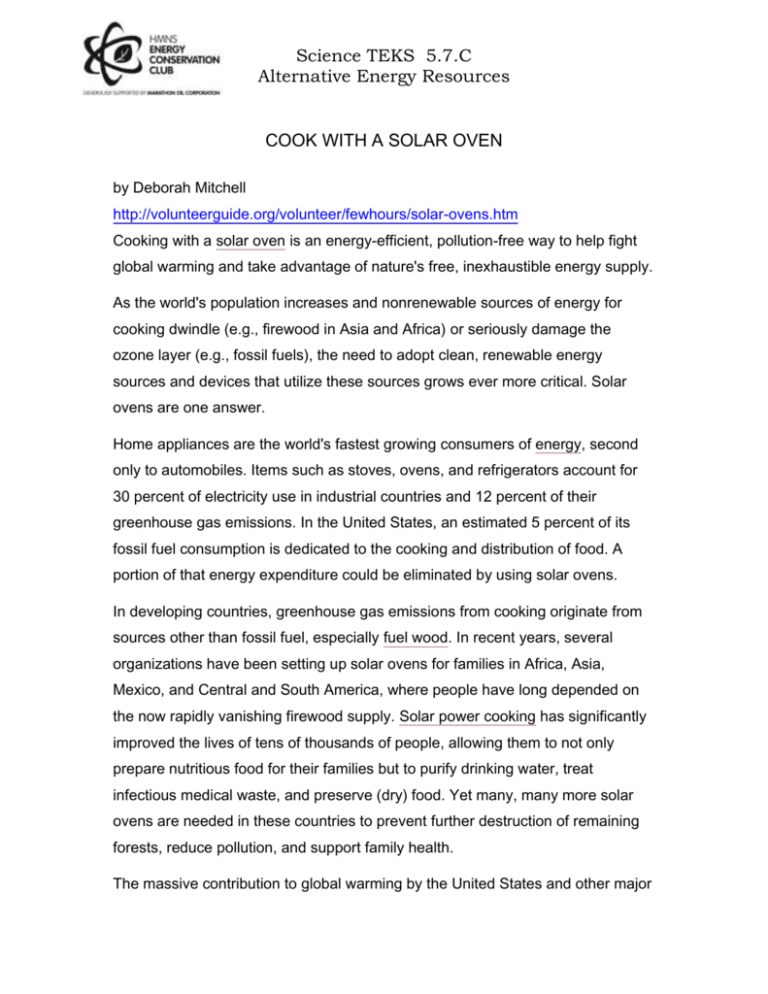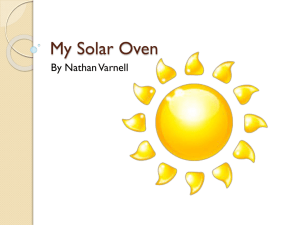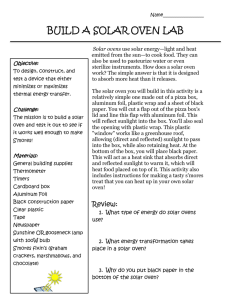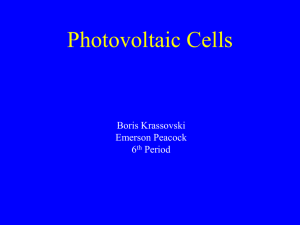COOK WITH A SOLAR OVEN
advertisement

Science TEKS 5.7.C Alternative Energy Resources COOK WITH A SOLAR OVEN by Deborah Mitchell http://volunteerguide.org/volunteer/fewhours/solar-ovens.htm Cooking with a solar oven is an energy-efficient, pollution-free way to help fight global warming and take advantage of nature's free, inexhaustible energy supply. As the world's population increases and nonrenewable sources of energy for cooking dwindle (e.g., firewood in Asia and Africa) or seriously damage the ozone layer (e.g., fossil fuels), the need to adopt clean, renewable energy sources and devices that utilize these sources grows ever more critical. Solar ovens are one answer. Home appliances are the world's fastest growing consumers of energy, second only to automobiles. Items such as stoves, ovens, and refrigerators account for 30 percent of electricity use in industrial countries and 12 percent of their greenhouse gas emissions. In the United States, an estimated 5 percent of its fossil fuel consumption is dedicated to the cooking and distribution of food. A portion of that energy expenditure could be eliminated by using solar ovens. In developing countries, greenhouse gas emissions from cooking originate from sources other than fossil fuel, especially fuel wood. In recent years, several organizations have been setting up solar ovens for families in Africa, Asia, Mexico, and Central and South America, where people have long depended on the now rapidly vanishing firewood supply. Solar power cooking has significantly improved the lives of tens of thousands of people, allowing them to not only prepare nutritious food for their families but to purify drinking water, treat infectious medical waste, and preserve (dry) food. Yet many, many more solar ovens are needed in these countries to prevent further destruction of remaining forests, reduce pollution, and support family health. The massive contribution to global warming by the United States and other major Science TEKS 5.7.C Alternative Energy Resources energy-consuming nations highlights the need for pollution-free alternatives to ozone-depleting technology. Solar ovens are just one part of the alternative energy picture, but one that is accessible to a great majority of people. A reliable solar oven can be built from everyday materials in just a few hours or purchased ready made. Solar ovens can be used to prepare anything that can be made in a conventional oven or stove — from baked bread to steamed vegetables to roasted meat. Solar ovens allow you to do it all, without contributing to global warming or heating up the kitchen and placing additional demands on cooling systems. Are you ready to let the sun shine in? Make A Pizza Box Solar Oven http://www.going-green-challenge.com/solar-oven-for-kids.htm http://www.hometrainingtools.com/build-a-solar-ovenproject/a/1237/bhcd2/1262811159/ http://www.nmsea.org/Curriculum/4_6/pizza_box_oven/pizza_box_ovens.htm The pizza box solar oven is a great project for kids because it demonstrates two of the three basic principles of passive solar design working in concert with each other to accomplish a goal the kids can really relate to: making something yummy! Cooking food takes alot of energy! By using solar energy, we can save alot on fuel. Cooking takes time, and the Sun will change position during that time. Therefore, somebody, such as a vigilant cook, may need to align the solar oven now and then to keep the sunlight entering. Mechanisms that track the sun and adjust the device automatically are called "heliostats" (like thermostat, but with "helio", which means "Sun", instead). Science TEKS 5.7.C Alternative Energy Resources Solar ovens have been used for a long time. In the 1830s, the British astronomer John Herschel used a solar collector box to cook food during an expedition to Africa. Nowadays, one can buy commercial solar ovens, ranging from small single dish units, to large units that can feed many people at once and that have to be hauled around on a trailer. Without the reflector flap, the solar oven becomes what is called a "flat plate collector". Flat plate collectors are used for many applications, such a heating water (the reason for not using a reflector is that it is not really needed for these applications- and thus alignment difficulties associated with reflectors can be avoided). One of the first known uses of solar hot boxes was by the cooks of the Roman Emperor Tiberius who wanted to eat cucumbers all year round. The cooks satisfied his regal appetite by using a solar hot box, a kind of flat plate collector, to grow the cucumbers all winter long! Nowadays, many people also use flat plate collectors to heat water for their pools and houses. The simplest pizza box solar oven design, as given below, can get up to two hundred degrees Fahrenheit on a warm sunny day, enough, for example, to make "s'mores" (graham cracker sandwiches of chocolate chips and marshmallows). Several optional features will enable the oven to get even hotter, which may be desirable in cooler weather, or for more serious cooking. One should allow ample time for cooking - roughly twice as long as would take in a conventional oven, and for smore's, it works best to leave the sandwiches open while cooking so that direct sunlight falls on the marshmellows and chocolate chips). We do not recommend trying to use the oven outside in temperatures below about 60 degrees Fahrenheit. If its cool outside, try a sunny window sill. Note: Many pizza shop owners will be more than willing to donate boxes. In return, you may want to ask a local reporter to cover the event, and ask the reporter to specifically mention the pizza shop's donation in any news article that Science TEKS 5.7.C Alternative Energy Resources appears. Materials needed for a single oven (simplest design) 1 large size pizza box oven Several feet of aluminum foil 1 sheet black construction paper 2 1/2 feet of clear plastic wrap 4 feet of masking tape 2 feet of string Note: Avoid materials that you think might become toxic when heated Tools needed scissors (teachers or older students may also want to have an exacto knife on hand, to better be able to cut cardboard with). ruler marker Instructions Assemble the pizza box, and open it up. Glue aluminum foil to all inside surfaces of the sides except the top of the box, with the shiny surface facing in. This will create a "radiation trap" that will trap, by reflection, invisible (low-frequency) radiation that is radiated by the food and air inside the box. On the top flap of the pizza box draw a square with a marker with edges spaced 1" from the four sides of the box. Cut along three of the lines, on the sides and on the front edge of the box, leaving the fourth line along the box's hinge uncut. Then fold open the flap, making a crease on the fourth line (see the figure above). Note: Science TEKS 5.7.C Alternative Energy Resources Extra supervision make be needed during this step, because students often cut along the fourth line as well by mistake. Glue aluminum foil to the inside surface of the top flap, with shiny side visible! This will form reflector, to reflect sunlight into the oven. Be careful to make as few wrinkles as possible, and smooth out whatever wrinkles occur. Tape the black construction paper to the bottom of the box. This will help to absorb the incoming sunlight. Carefully stretch the plastic wrap over the opening of the box, sealing the edges with tape to seal the air in. Cover any air leaks around the box edges with tape, except while making sure that the box can still be opened, so you can place food inside the box and remove it later. Go outside in the sunlight and place oven on a flat, level surface. Place food on some foil (or a paper plate) and place inside the oven. Use string and masking tape to tie back and adjust the reflector, so that sunlight is reflected into the oven, and especially onto the pie tin. Let food cook, and check reflector angle now and then to make sure sunlight is getting inside the oven. Enjoy your solar treat! Optional Features Add additional flaps to reflect sunlight into the oven. This can substantially increase the gain of the oven. This will require some extra cardboard (from some old boxes for example), and some extra foil, glue, and string to adjust the flaps. Crumple up some sheets of newspaper and stuff them around the inside of the box, to provide extra insulation. Add an additional layer of saran wrap across the box opening, but attached to the inside surface of the top flap, such that an air space is created Science TEKS 5.7.C Alternative Energy Resources between the layers of wrap (the plastic is bound to stick together in some places: don't worry about this too much). Place a thermometer inside the oven as well, to measure the temperature. The earliest pizza box solar oven design we are aware of was created in 1976 by Barbara Kerr.









